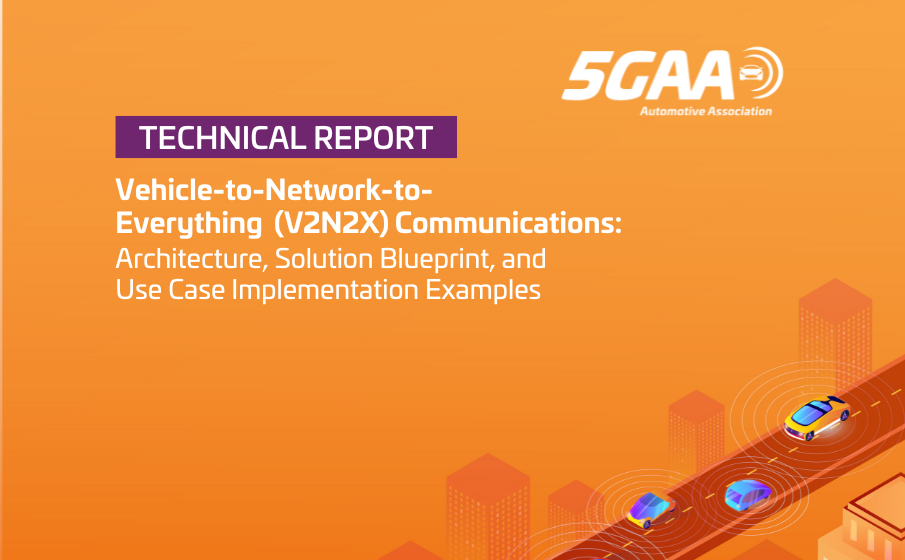
Vehicle-to-Network-to-Everything (V2N2X) Communications: Architecture, Solution Blueprint, and Use Case Implementation Examples
This technical report builds on the 5GAA white paper “Road traffic operation in a digital age” and guides stakeholders on implementing various vehicle-to-everything (V2X) applications using cellular networks and information sharing structures between backend systems.
It presents an application-level reference blueprint architecture and introduces an “information sharing domain” to enable scalable digital data exchange among stakeholders such as vehicle manufacturers, service providers, and infrastructure operators. The report details how to implement V2X applications that enhance safety and mobility, with examples including traffic event and signal information sharing, emergency vehicle approaching alerts, automated valet parking, and vulnerable road user protection. It also explains different implementation options for these applications within vehicles, distinguishing between OEM-controlled, OEM-supported, and OEM-independent apps.
Additionally, it describes proven solutions and references initial deployments like C-Roads and Talking Traffic, highlighting their effectiveness in accelerating V2X service adoption. Ecosystem stakeholders are encouraged to use this document as a guide for deploying V2X services using cellular networks and information sharing, with the potential to address more demanding use cases through enhanced cellular network capabilities.
Read the full report here.
For more information, find the complementary technical report “Business Perspectives on Vehicle-to-
Network-to-Everything (V2N2X) Deployments.”
A 5GAA online session on the V2N2X topic and reports took place on 18 June 2024. The recording of the online session can be accessed here. The slides of the presentation can be accessed here.
The paper was originally published in May 2024. The current downloadable version is the updated edition, released on 3 June 2025. 5GAA remains committed to keeping all its publications accurate and up to date.
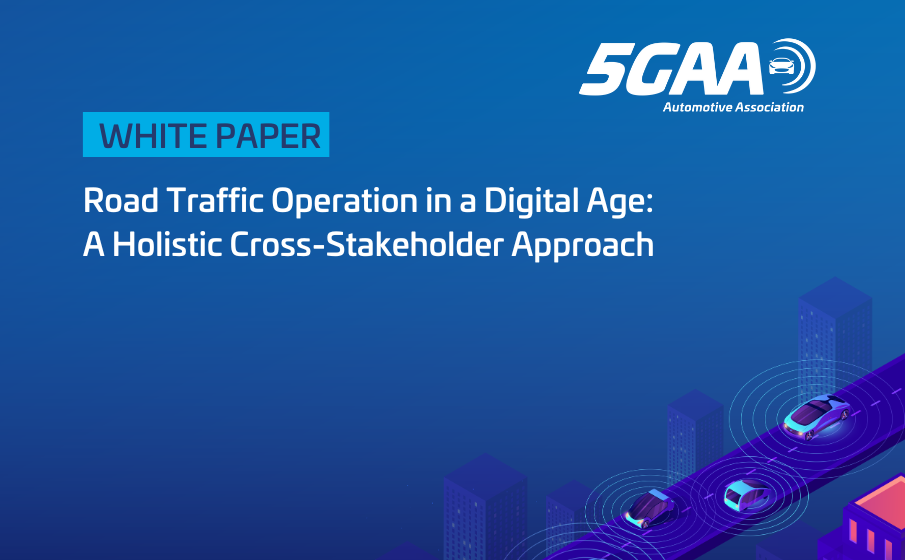
Road Traffic Operation in a Digital Age: A Holistic Cross-Stakeholder Approach
The societal ambitions of zero fatalities and climate neutrality in road transportation, as well as future ambitions of automated driving require a new approach to the handling of road traffic information. The key stakeholders of the ecosystem, global automotive OEMs, service providers (SPs) and infrastructure owner-operators (IOOs), need new digital methods of operating and interworking.
This white paper proposes a transformative approach for automotive stakeholders, emphasizing scalable digital data exchange and a federated architecture to manage road traffic information efficiently. The architecture ensures bidirectional communication, delivering static, semi-static, and near real-time data for safe and efficient transportation. The paper concludes with recommendations for a National Roadway Digital Strategy, federated information-sharing structures, and aligned investments. Emphasising the integration of technologies and data-driven decision-making, it aligns with 5GAA’s mission to propel road traffic operations into the digital age.
Read or download the full white paper here.
The paper was originally published in January 2024. The current downloadable version is the updated edition, released on 3 June 2025. 5GAA remains committed to keeping all its publications accurate and up to date.
Note: To complement this white paper with further technical details and business considerations, 5GAA has developed two technical reports and one position paper:
- Technical Report “Vehicle to Network to Everything (V2N2X) Communications; Architecture, Solution Blueprint, and Use Case Implementation Examples”: This technical report describes for different ecosystem stakeholders how to realise various V2X applications and use cases (UCs), using cellular network communications in combination with information sharing structures between backend systems. It also clarifies the different implementation options of the V2X application in a vehicle and their related implications. In this report, readers can also find verified V2N2X solutions and references to initial operational deployments that realize the suggested application-level reference architecture, e.g., C-Roads, Talking Traffic, Mobilidata, etc. The document is available here.
- Technical Report “Business Perspectives on Vehicle-to-Network-to-Everything (V2N2X) Deployments”: This technical report describes the V2N2X market from a business standpoint, encompassing market dynamics, stakeholder analysis, and business models deployed in various exemplary instances. The document is available here.
- Position paper “V2N2X security, privacy, and data quality”: This position paper provides an overview of how security, privacy, and data quality are addressed for C-V2X using mobile network and backend communications, with highlights on the different characteristics and approaches in comparison with C-V2X direct communications. The document is available here.
A 5GAA online session on the V2N2X topic and reports took place on 18 June 2024. The recording of the online session can be accessed here. The slides of the presentation can be accessed here.

Driving the Future: 5GAA Brings First-Ever Satellite and 5G-V2X Direct Vehicle Connectivity to Life in Paris
- In a global premiere, 5GAA members demonstrated connected vehicles using non-terrestrial networks (NTN), complementing terrestrial 4G and 5G networks
- The event featured the first on-the-road, live-traffic demonstration of 5G-V2X Direct technology capabilities for advanced connected mobility services
- 5GAA members showcased ready-to-deploy vehicle-to-network (V2N) technologies improving road safety in real traffic conditions
PARIS, 15 May 2025 — For the first time worldwide, the 5G Automotive Association (5GAA) showcased connected vehicles using non-terrestrial networks (NTN) for emergency messaging, as well as 5G-V2X Direct for advanced detection of vulnerable road users (VRU) in real-traffic conditions. 5GAA members also demonstrated the readily available capabilities of Vehicle-to-Network (V2N) services.
“Today, we saw real vehicles on real roads, connected through cutting-edge technologies such as satellite, 5G-V2X Direct and commercial networks. This is the future of automotive connectivity, and it’s closer than you think,” said 5GAA Chairman Christoph Voigt.
5GAA members, vehicle manufacturers BMW Group and Stellantis and technology partners Anritsu,Cubic³, Deutsche Telekom, HARMAN, Jember, LG Electronics, Qualcomm Technologies, MediaTek, Rohde & Schwarz, Rolling Wireless, Skylo, VEDECOM Institute and Viasat demonstrated NTN satellite connectivity. Demonstrations focused respectively on realising hazard warning and emergency messaging use cases in the vehicle, as well as illustrating how NTN will complement terrestrial 4G and 5G networks in the future. Demonstrations on public roads emphasised the vision of how NTN can support ubiquitous automotive connectivity for connected services with seamless integration and switching between NTN and terrestrial networks to enable voice communication. In the future, car drivers may not even realise that satellite connectivity is being established instead of using a terrestrial network. According to 5GAA 2030 Roadmap, the initial market deployment of satellite connectivity in vehicles is expected by 2027 (based on IoT NTN 3GPP Release 17).
Anritsu, Keysight Technologies, Rohde & Schwarz, and MediaTek complemented the NTN demonstrations with parallel test equipment measurements for performance verification.
For the first time on the road, 5GAA member Valeo, in collaboration with Marben, demonstrated 5G-V2X Direct, in which two vehicles shared sensor data, triggering a warning of a pedestrian crossing at an obstructed intersection. This demonstration illustrated how 5G-V2X Direct (based on 3GPP Release 16) will enable vulnerable road users’ advanced protection by leveraging sensors and camera feeds from other vehicles to alert drivers, paving the way for smarter mobility. As per the 5GAA Visionary 2030 Roadmap, 5G-V2X is expected to be mass-deployed in commercial vehicle models starting from the time horizon 2026-2029.
The public road demonstrations continued with V2N technology for road users’ protection. 5GAA members, including Nokia, Orange, Stellantis, Valeo, and VEDECOM Institute, showcased interoperable V2X Platforms with vehicles, mobile applications and smart intersections (equipped with cameras and connected via the 5G networks) sharing collective perception to enhance road users’ safety. Additionally, HARMAN and u-blox showcased Emergency Electronic Brake Light (EEBL) near-real-time alerts to prevent hard braking events, in line with the upcoming 2026 Euro NCAP local hazard requirements, and used precise positioning techniques to prevent false alerts.
5GAA members Rohde & Schwarz, S.E.A., Keysight and Orange alsoexhibited Next Generation Emergency Call (NG eCall) verification and network performance.
The event, hosted by Telecom-Paris, highlighted how 5GAA is developing new standards for safety and innovation in automotive connectivity in Europe and globally.
Please see our brochure about the Paris demonstrations here.
A French version of this press release is also available for our French-speaking audience here.
Discover What Our 5GAA Members Are Saying here.
About the 5GAA
The 5G Automotive Association (5GAA) is a global, cross-industry organisation of more than 110 members, including leading global automakers, Tier-1 suppliers, mobile operators, semiconductor companies, and test equipment vendors. 5GAA members work together to develop end-to-end solutions for future mobility and transport services. 5GAA is committed to helping define and develop the next generation of connected mobility, automated vehicles, and intelligent transport solutions based on C-V2X. For more information about 5GAA, please visit www.5gaa.org.

5GAA Conference: France 2030 & Beyond: Accelerating Connected Mobility
On 15 May 2025, the 5G Automotive Association (5GAA) will host a full day of high-level discussions and real-world demonstrations in Paris, spotlighting the latest V2X innovations in France and across Europe.
Key Topics
The day will begin with the “France 2030 & Beyond: Accelerating Connected Mobility” conference at La Défense. This conference will gather key industry leaders, policymakers, and regulatory experts to discuss the future of V2X in France and Europe, focusing on cooperative, connected, and automated mobility (CCAM).
Discussions will focus on accelerating the market deployment of CCAM technologies and the key enablers needed for future mobility. Highlights include expert panels on what the automotive industry needs to scale connected mobility services and the role of Non-Terrestrial Networks (NTN) in delivering large-scale, reliable V2X solutions.
Experience the Technology
In the afternoon, participants will travel to Paris-Saclay, to experience first-hand the latest C-V2X innovations by 5GAA members in the Paris Télécom University area:
- First-ever demonstration of NTN technology applications for the automotive sector, allowing for seamless ubiquitous connectivity.
- Vehicle-to-Network (V2N) services showcase for Vulnerable Road Users’ protection at intersections and safety alerts between vehicles in case of hard braking ahead, toemphasize the market readiness and fast-scaling potential of network-based technologies.
- First-ever on-road 5G-V2X Direct (3GPP Release 16) demonstration of sensor-sharing between vehicles for Vulnerable Road Users (VRU) detection at an obstructed intersection, on-road and in real-traffic conditions.
Please see our brochure about the Paris demonstrations here:
https://5gaa.org/content/uploads/2025/05/5gaa-paris-demos-media-kit-14.05.2025.pdf
Media contact: marcom@5GAA.org

5GAA to Host High-Level Conference and Live Demos in Paris
On 15 May 2025, the 5G Automotive Association (5GAA) will host a full day of high-level discussions and real-world demonstrations in Paris, spotlighting the latest V2X innovations in France and across Europe.
Key Topics
The day will begin with the “France 2030 & Beyond: Accelerating Connected Mobility” conference at La Défense. This conference will gather key industry leaders, policymakers, and regulatory experts to discuss the future of V2X in France and Europe, focusing on cooperative, connected, and automated mobility (CCAM).
Discussions will focus on accelerating the market deployment of CCAM technologies and the key enablers needed for future mobility. Highlights include expert panels on what the automotive industry needs to scale connected mobility services and the role of Non-Terrestrial Networks (NTN) in delivering large-scale, reliable V2X solutions.
Experience the Technology
In the afternoon, participants will travel to Paris-Saclay, to experience first-hand the latest C-V2X innovations by 5GAA members in the Paris Télécom University area:
- First-ever demonstration of NTN technology applications for the automotive sector, allowing for seamless ubiquitous connectivity.
- Vehicle-to-Network (V2N) services showcase for Vulnerable Road Users’ protection at intersections and safety alerts between vehicles in case of hard braking ahead, toemphasize the market readiness and fast-scaling potential of network-based technologies.
- First-ever on-road 5G-V2X Direct (3GPP Release 16) demonstration of sensor-sharing between vehicles for Vulnerable Road Users (VRU) detection at an obstructed intersection, on-road and in real-traffic conditions.
Stay tuned for more information, event highlights and key takeaways, which will be shared on the 5GAA website and social media following the conference!
If you wish to participate, contact us at marcom@5gaa.org.
We look forward to welcoming you to Paris for this groundbreaking event!
Exclusive Media Tour!
Join us In Paris!
The 5GAA’s tech demonstrations offer an unparalleled opportunity to learn from industry leaders and explore the future of automotive connectivity.
If you would like to attend physically the media tour from 10:30 to 12:30 pm CEST or request interviews with key speakers and experts, please contact us at marcom@5gaa.org
For further information
Please see our brochure about the Paris demonstrations here:
https://5gaa.org/content/uploads/2025/05/5gaa-paris-demos-media-kit-14.05.2025.pdf
Media contact: marcom@5GAA.org
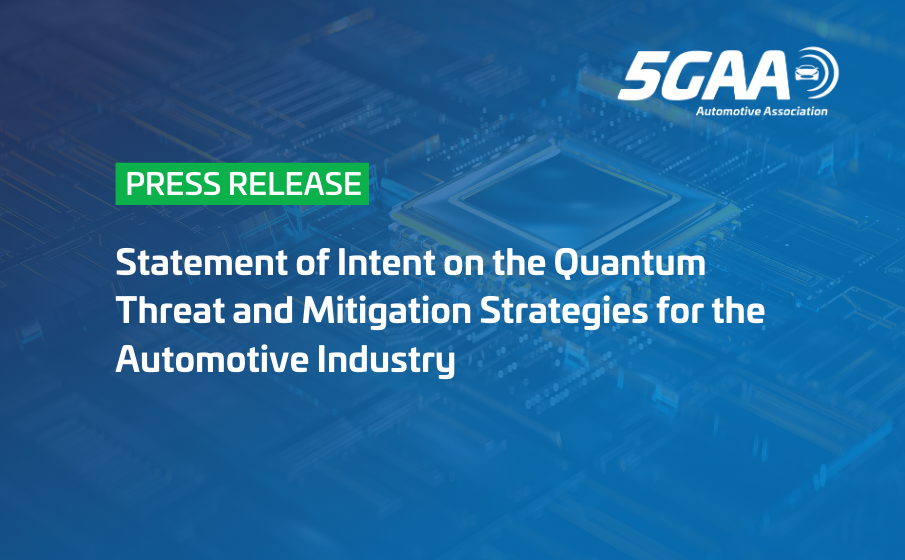
5GAA Issues Statement of Intent on the Quantum Threat and Mitigation Strategies for the Automotive Sector
As part of its cooperation agreement with GSMA, 5GAA intends to work with the GSMA Post-Quantum Telco Networks (PQTN) Task Force to explore the impacts that quantum computing and the migration to post-quantum cryptography has on the connected automotive sector and its customers. Through this cooperation, 5GAA and the GSMA PQTN Task Force will gain insights to help both the telco and automotive industries strengthen the future of connected automotive security with post-quantum cryptography and crypto-agility. The rapid evolution of automotive E/E architecture and Software-Defined Vehicles has transformed modern vehicles into highly connected computing platforms, enabling advanced functionalities such as Vehicle-to-Everything (V2X) communication, autonomous driving, and over-the-air updates. This increasing connectivity significantly expands the attack surface for bad actors, making vehicles more exposed to cyber threats.
Read and download the full statement here.

Experience the Future of Connected Mobility at MWC 2025 with 5GAA
Join us at Mobile World Congress (MWC) 2025, taking place from March 3-6 at the Fira Gran Via in Barcelona, to explore the latest advancements in connected-vehicle technologies.
Many connected-vehicle services are becoming mission-critical. Customers want ubiquitous connectivity. Today it comes via the cellular networks, tomorrow also via satellite communications. Networks also need to be resilient, or available even under exceptional conditions such as disaster scenarios or periods of overwhelmingly high network usage.
The 5G Automotive Association (5GAA) brings together leading players from the telecommunications, automotive, and technology industries to drive innovation in mobility. This year, At MWCB 2025, 5GAA members will showcase the latest connected vehicle technologies including ubiquitous, reliable, and low latency connectivity using cellular, NTN, multi-access edge computing, and C-V2X Direct.
Visit the 5GAA booth in Hall 6, Stand 6E64, and tour our members’ stands to see firsthand how we are shaping the future of mobility.
Exclusive Press Tour
Media representatives are invited to join a guided press tour, featuring insights from 5GAA CTO Maxime Flament and representatives from BMW and Verizon, along with exclusive visits to the stands of Harman, Deutsche Telekom, Ericsson, Huawei, MediaTek, Nokia, Keysight Technologies, Anritsu, and Rohde & Schwarz. Journalists interested in participating can register by contacting us at marcom@5gaa.org.
5GAA at MWC 2025
Our CTO Maxime Flament will speak at several key sessions throughout the week, including:
– Digital Infrastructure of the Future: Shaping Europe’s Competitive Edge
– Security Summit: Post-Quantum Cryptography and its Relevance to Connected Mobility
– GSMA’s Global 5G Alliances Summit
– GSMA’s Smart Mobility Summit: Building the backbone: The Infrastructure Behind Modern Mobility
For more information, meeting requests, or press inquiries, contact the 5GAA Marketing and Communications team at marcom@5gaa.org.
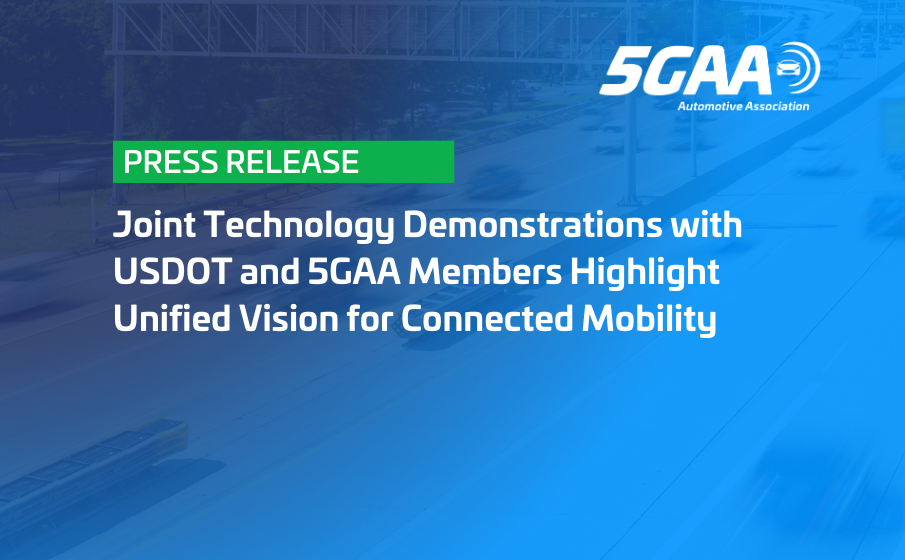
Joint Technology Demonstrations with USDOT and 5GAA Members Highlight Unified Vision for Connected Mobility
Washington, D.C., 6 February 2025 – For the first time, the U.S. Department of Transportation (USDOT) and members of the 5G Automotive Association (5GAA) have partnered to showcase the complementarity of Cellular Vehicle-To-Everything (C-V2X) direct and mobile network communications at the Federal Highway Administration’s Turner-Fairbank Highway Research Center.
The live demonstrations illustrated the potential of connected-vehicle technologies to make American roads safer and more efficient. This public-private initiative also outlined the benefits of interworking communication modes for a unified transportation system.
“5GAA commends USDOT for its leadership in advancing V2X technology through government-industry collaboration, critical for nationwide deployment,” said 5GAA Chairman Christopher Voigt. “We applaud USDOT’s commitment to seizing the full safety potential of V2X by integrating direct and mobile network communications to achieve 360° awareness.”
Participants had the opportunity to experience several use cases:
- Verizon showcased near real-time alerts enabled by C-V2X mobile network communications and mobile edge computing (MEC). Demonstrated capabilities included connected signalized intersection and delivery of pedestrian alerts, variable speed warnings, and weather warnings.
- Audi, in collaboration with Spoke and the Coalition for Cyclist Safety, used C-V2X direct communications to address safety scenarios that often result in cyclist fatalities. The seamless integration of aftermarket solutions and in-vehicle systems is a clear example of leading automakers’ increasing interest in this technology.
- Autotalks illustrated how C-V2X direct communications can prevent same-lane accidents: in their demo, a car swerved abruptly to avoid a stopped bicycle, showcasing the system’s potential to protect cyclists outside intersections.
5GAA also gathered industry and government leaders to identify main drivers for deployment, such as the reauthorization of federal transportation funding. The event underpinned the critical role of C-V2X in achieving USDOT’s National Roadway Safety Strategy targets, as well as the industry’s commitment to help implement the National V2X Deployment Plan released in August 2024.
With this, the foundation is laid to leverage the existing tens of millions of connected road users and accelerate the nationwide rollout of connected-vehicle and connected-road infrastructure technologies, bringing us closer to the shared vision of zero traffic fatalities on American roads.
About 5GAA
The 5G Automotive Association (5GAA) is a global, cross-industry organization of more than 110 members, including leading global automakers, Tier-1 suppliers, mobile operators, semiconductor companies, and test equipment vendors. 5GAA members work together to develop end-to-end solutions for future mobility and transport services. 5GAA is committed to helping define and develop the next generation of connected mobility, automated vehicles, and intelligent transport solutions based on C-V2X. For more information about 5GAA, please visit www.5GAA.org.
For further information please contact:
5GAA Marketing & Communications – Marcom@5GAA.org
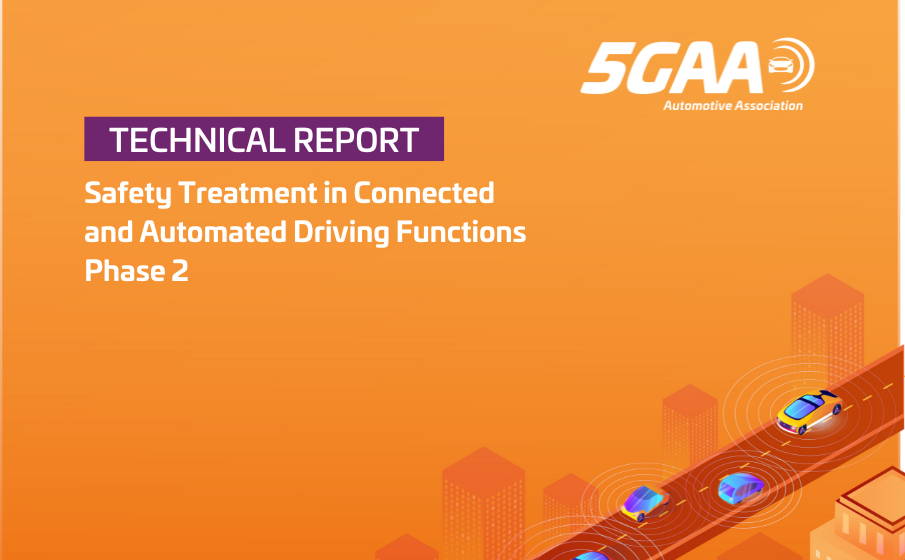
Technical Report: Safety Treatment in Connected and Automated Driving Functions, Phase 2
The 5GAA Technical Report on Safety Treatment in Connected and Automated Driving (STiCAD II) documents the latest findings on enhancing safety in V2X-enabled automated driving. Building on the first STiCAD work item, this report explores additional use cases requiring safety treatment, such as sensor sharing and automated valet parking, and introduces a simplified functional safety analysis approach. A key focus is the mutual trust concept, covering technical, organisational, and certification aspects essential for reliable V2X communication. The report also examines potential standardisation contributions and network reliability enhancements.
Download the document here.
A related white paper provides a high-level overview.
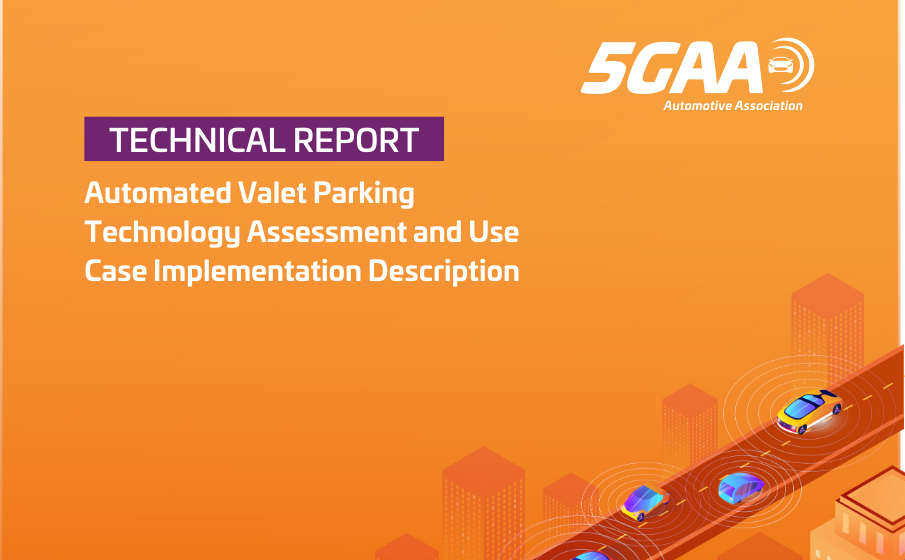
Automated Valet Parking Technology Assessment and Use Case Implementation Description
The 5GAA Technical Report on Automated Valet Parking (AVP) Type-2 outlines the technological framework and implementation details for driverless parking systems. It explores the role of Vehicle-to-Everything (V2X) communication, cellular public networks, Stand-alone Non-Public Networks (SNPN), and PC5 Direct Communication in enabling seamless and secure AVP operations. Key aspects include system architecture, interoperability, security, and deployment considerations. The report emphasises standardisation to ensure cross-vendor compatibility and provides recommendations for optimising network performance. Serving as a reference for automotive and telecommunications stakeholders, it offers actionable insights into scaling AVP solutions while addressing critical safety and operational challenges.
Find the document here.


